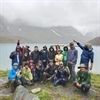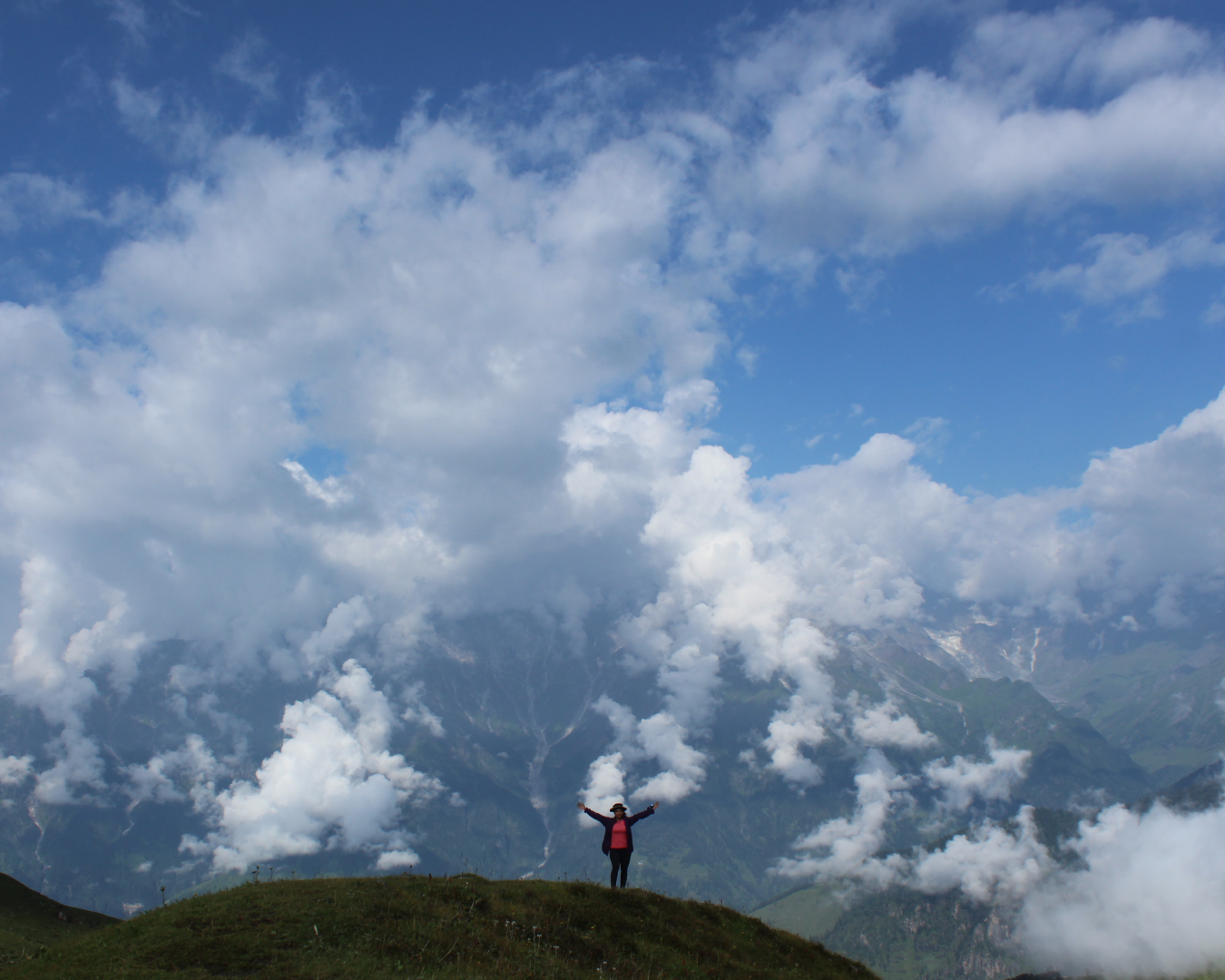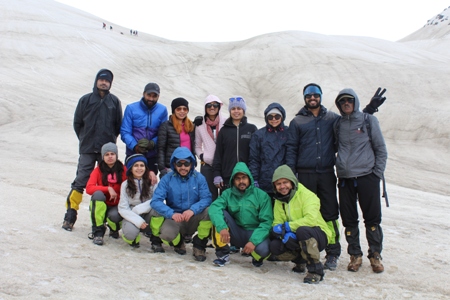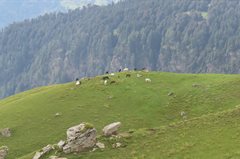Bhrigu Lake Trek
A Weekend Escapade into the prettiest grassland of Himachal
Available Batches



Brief Description
Brief Itinerary
Detailed Itinerary
Day 1
Drive from Manali (2050 M) to Gulaba (3,000M) and trek from Gulaba to Rola Kholi (3,810M) (Click to View GPS data)
Distance: 23 kms drive + 7 kms trek
Duration: 2 hours + 6 hours
Drive from Manali to Gulaba
Manali, the populous tourist town is the starting point for many treks in Himachal Pradesh like Beas Kund, Bhrigu Lake, and Hampta Pass. Manali main bus terminus is the assembly point where all trekkers are expected to arrive before 9 AM. We will do a quick headcount and start driving towards Gulaba. The drive from Manali to Gulaba is a fascinating journey. The 23 km to Gulaba should take us 2 hours to cover.
As soon as we start from Manali, for the first 20 minutes the roads will take you through the cultural lanes of Himachali tradition. Look out for the old heritage buildings, vibrant attires of the natives, and small flea markets on the corner of the streets. We can pick up some souvenirs at the end of the trip. As we pass through the huge metallic bridges to cross the Beas river, small twinkling stars will pop up and keep us company when the sun rays reflect on the mighty Beas river.
45 minutes into the drive, the Beas River will disappear behind us and we will enter into the famous Rohtang Pass. The road will divert to our right from the Rohtang Pass and enter into the Kullu district. Lush green and golden apple trees will wave their branches to welcome us on both sides of the roads. Once we cover a distance of 15 km, our vehicle will cross through fresh cotton clouds. It will cleanse our mind, body, and soul. During the monsoon season, we can witness the monsoon clouds joining together and making doodles in the sky. Keep your eyes peeled for the valiant hosts of Gulaba – The Vultures. They patrol the sky to keep us in check.
After 21 km, we will cross a government check post. They will take a headcount, check the necessary documents and allow us to go ahead. In 2 more km, we will reach the starting point of the trail – Gulaba.
Gulaba (3,000M) to Rola Kholi (3,810M)
Distance: 7 km
Duration: 6 Hours
The trail for the Bhrigu Lake trek begins from Gulaba. We will cross the road and start walking at around 11 AM. The water source for the day is small mountain streams between every 3 km and the terrain comprises of steep ascents and no descents.
In the beginning, for the first 30 minutes, the trails will be covered with dense oak trees, pine trees, Himalayan Birch, and shrubs. The mystic woods, moist leaves, and the hums of the insects will create a groovy song to keep us entertained. We jump, move and groove with the beat. The pathway will bend and twist like a snake and lead us through some water mist created from the monsoon clouds. (White-outs are a common factor in monsoon treks)
At the end of 2 km, the forest line ends and captivating grasslands take over the landscape. The rolling meadows extend for 5 km till Rola Kholi. Usually, it takes more time and a long distance to reach any Himalayan grassland from the base point of a trek. But on the Bhrigu Lake trek, it just takes 2 km and 30 minutes.
3 kms into the journey, the first water stream appears. We can fill our bottles and settle for lunch there. To make our journey more colourful, the terrain from the lunch point is completely covered with wildflowers. If we get lucky we can find some dry Dandelion flowers. Make a wish and blow it.
The sparkling colours of the flowers on the grassland fluctuate with different shades for the next 2 km. If we stop here and look back, we get a glimpse of the stunning Solang Valley and Beas Kund Valley. Once we cover a distance of 6 km in 5 hours, the pathway gets steeper and ascends towards the high ground. After finishing 7 km in 6 hours we reach a plain land near a big mountain stream. Thais is our Campsite for the day – Rola Kholi. Rola Kholi is a natural podium to stand and observe the stars and star dust in the night and witness the magnificence of Seven Sister Peaks, Deo Tibba, Solang Valley, Hanuman Tibba, and Beas Kund Valley in the day. The spectacles are bound to stay with us forever.
Day 2
Rola Kholi (3,810M) to Bhrigu Lake (4267 M) (Click to View GPS data)
Distance: 5 kms
Duration: 4 hours
Today, the terrain and the trails continue with challenging ascents and are covered in scree, boulders, and broken rocks. There are few water sources, so carry enough bottles to support yourself.
We leave our camp around 9 AM and carry packed lunch with us. We cross the stream next to the campsite and start ascending. Just 10 minutes after the first ascent, the land opens up to a huge boulder and a wider skyline. From this spot, we can get a clean and panoramic view of the Seven Sister peaks, Deo Tibba, Solang Valley, Hanuman Tibba, and Beas Kund Valley. The grasslands from the boulder point come under the shepherd’s domain. For the next 2 kilometres, we can see many horses and cows grazing over the fresh grass covered in dewdrops.
The green tinge of the grassland dilutes and disappears at the end of 2 km. A mix of wild grey and light brown colours take over the landscape. The nature of the trail completely changes here. Be prepared to cross over boulders, narrow ascents filled with scree and rocky pathways. It is best to be with the group and follow the instructions of your trek leader while trekking through these trails. Because of frequent whiteouts, people tend to lose their way and get stuck in-between the rocks.
After covering a distance of 4 km, the trails incline towards a 30-degree ascent for another 1 km. Look down for the small flowers that sneak out and flash their bling through the cracks of the boulders. It’s a masterpiece in the mountains. Finally, at the end of 1 km, we reach a high ground with a fabulous view of Bhrigu Lake. Bhrigu Lake is a beautiful marvel which changes its colour according to season. During monsoon and summer, it changes from olive green to emerald green. During the winters it completely gets frozen and turns into pearl white colour. We stop for lunch near the lake, spend some quality time there and start heading back towards the campsite in Rola Kholi.
Day 3
Rola Kholi (3,810M) to Gulaba (3,000M) (Click to View GPS data)
Distance: 7 kms
Duration: 4 hours
After dismantling the campsite and packing everything, we leave Rola Kholi at around 8 AM and reach Gulaba by 12 PM. The trail for today is less demanding with easy descents. A dedicated vehicle will pick us up from Gulaba and drop us back at Manali bus terminus around 2 PM. If you are traveling by flight, it is advisable to stay for the night, rest, and leave the next day. Manali roadways are prone to heavy traffic because of tourist attractions.
What's Included
- Veg Food (Day 1 Evening snacks to Day 3 Packed lunch). Three Meals a day
- Forest Permits/Camping Charges/Permits, Trek Permit Fee/IMF Permission (Upto the amount charged for Indian nationals)
- Camping tents, Temp rated sleeping bags, mattress
- Micro-pikes & Gaiters, if required
- Mountaineering course certified Trek Leader with First Aid certification
- Experienced Local guide, cook, helpers
- Porters or mules for carrying common luggage
- Transportation from Manali to Manali
What's Not Included
- Meals during road journeys
- Any kind of Insurance
- Any expense of personal nature
- Any expense not specified in the inclusion list
Are you Eligible for this Adventure?
BRS Level Required
Since it is a beginner’s trek, you need no special prior experience. Although any high-altitude trek requires a certain level of stamina and physical endurance.
If you do not know what level of BRS trek would suit you best, worry not! Fill out this Form:
we will send you a progression chart to help you comfortably get out of your comfort zone in order to level up and ultimately reach your highest potential in the big, bad world of outdoor adventure.
Packing List
This is a list of essential items for individuals doing the trek with Bikat Adventures. This list contains only those items which the participants are required to bring with them. The list excludes those items which are provided by Bikat Adventures on the trek. We have divided the items into five categories. All the items in the list are essential except for those marked as optional.
Trekking Gear
- Ruck sack bag with rain cover. Qty -1
- Day Pack Bag - Recommended for treks with summit day
- Head Torch with spare Batteries. Qty -1
- U V protection sunglasses. Qty -1 Here is how you can choose the best sunglasses for trekking.
- Water Bottles: 2 bottles of 1 liter each
Footwear
- Non-skid, deep treaded, high-ankle trekking shoes Qty -1
- Pair of light weight Slipper/Sandals Qty -1
Clothing
- Quick Dry Warm lower or Track Pants. Qty - 2
- Full sleeves T-shirts/ Sweatshirts. 1 for every 2 days of trekking
- Pair of thick woolen socks. 1 pair for every two days of trekking
- Thermal Body warmer Upper & Lower. Qty-1
- Undergarments. Qty - 1 for every day of trekking
- Warm jacket closed at wrist & neck .Qty-1
- Full sleeves sweater. Qty -1
- Rain wear ( Jacket & Pants ) . Qty-1
- Pair of waterproof, warm gloves. Qty-1
- Woolen cap. Qty-1
- Sun shielding Hat. Qty -1
Toiletries
- Personal toiletries kit (Small Towel, Toilet paper, paper soap, Bar soap, toothbrush, toothpaste, cold cream, etc.)
- Sun screen lotion small pack. Qty -1 Here is your Sun Protection 101 to stay safe in the bright sunny outdoors.
- Lip Balm small pack. Qty-1
Utensils
- Small size, Light weight & Leak proof lunch box. Qty-1
- Plate. Qty- 1
- Spoon.Qty-1
- Tea/Coffee (plastic) Mug.Qty-1
Miscellaneous
- Camera (Optional)
- Carry your medicines in plenty in case you have any specific ailment. Consult your doctor before joining the trek.
- Dry fruits, Nuts, Chocolate bars (Optional)
Frequently Asked Questions
Why Bikat?


Small Group Size
Our batch sizes are capped at 15 for smaller treks with the trek leader and trekker ratio of 1:8. This ratio, in our years of experience, has proven to deliver the best trekking experience for individuals as well as groups. Capping the size of the group ensures individual attention to each trekker so that no signs of distress or need during the trek go unnoticed. It also helps to form a more cohesive cohort with better group energy which helps define the rhythm and pace of days on the trek. As you go higher up on the BRS scale, since the stakes are higher, expeditions have an even smaller group size with the ratio of expedition leader to climber set at 1:2.


Qualified Trek Leaders
We follow a rigorous regime of hiring and training our experts in the field. Each trek leader is a certified mountaineer with years of experience in the field. In addition to their qualification, they also go through practical and situational training to tackle any and all kinds of sudden conditions that may present themselves on the ground. Being unpredictable is the core nature of the mountains but being ready for any circumstance as best as possible is a controllable asset that we try to nurture. Our field experts are also trained in basic medicine and first-aid response. Watch: Forerunners - The Making of A Trek Leader At Bikat Adventures


Guided Progression
Since Bikat Adventures is a learning-based organization, we help you climb up the ladder of difficulty within the sphere of outdoor adventure systematically. Our on-ground training modules are designed to handhold you through the upskilling process so that you are ready to take on bigger challenges.


Equipment Quality and Check
All the gear used on our treks and expeditions is tried and tested, maintained for good quality, and is overall top-notch in quality and condition. We are continually looking to obtain the best of everything there is in the market so as to ensure optimum safety.


Support Systems
Along with the staff you see on-ground, we have a team of superheroes working in the background to give you the best experience possible. Our background team also comprises local staff from each area who know the region best. Having local support helps with studying the area, pre-planning, execution, and in receiving timely support in case of emergencies in these remote locations.


Communication
Our on-field staff is in constant contact with our teams based in primary locations so as to eliminate any avoidable delay in reaching additional help and support when required. We try to use the best tools for communication available, including satellite phones, in regions where they are not restricted.
What our customers Say
Cancellation Policy
Cash refund
Cancellations up to 60 days prior to departure date
Between 60 days upto 30 days prior to departure date
Between 30 days upto 10 days prior to departure date
Less than 10 days prior to departure date
Voucher refund
Cancellations up to 30 days prior to departure date
Between 30 days upto 15 days prior to departure date
Between 15 days upto 10 days prior to departure date
Less 10 days prior to departure date
- Cash refund is applicable only in case of bookings made without using any promotional offer code or Cancellation Vouchers or Discounts
- This is only a brief of cancellation terms. For finer details please refer Detailed Cancellation Policy.
Blog Posts






Similar Adventures

Beas Kund Trek
A Beginners' Delight that takes you to the source of River Beas
Himachal
3 Days
BRS 2
3700 m

Chandrakhani Pass Trek
Himachal's Valley Of Gods
Himachal
4 Days
BRS 2
3660 m

Deoriatal Chandrashila Trek
An Adventure Steeped in Mythology
Uttarakhand
5 Days
BRS 2
3700 m






































